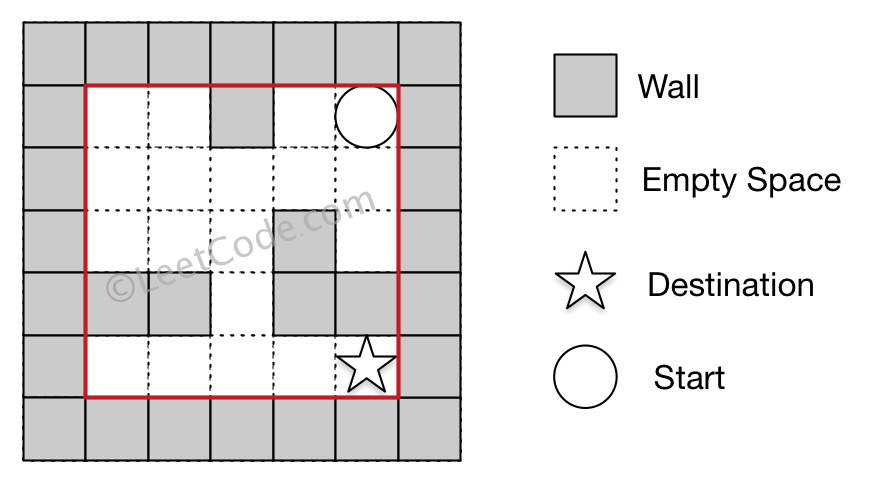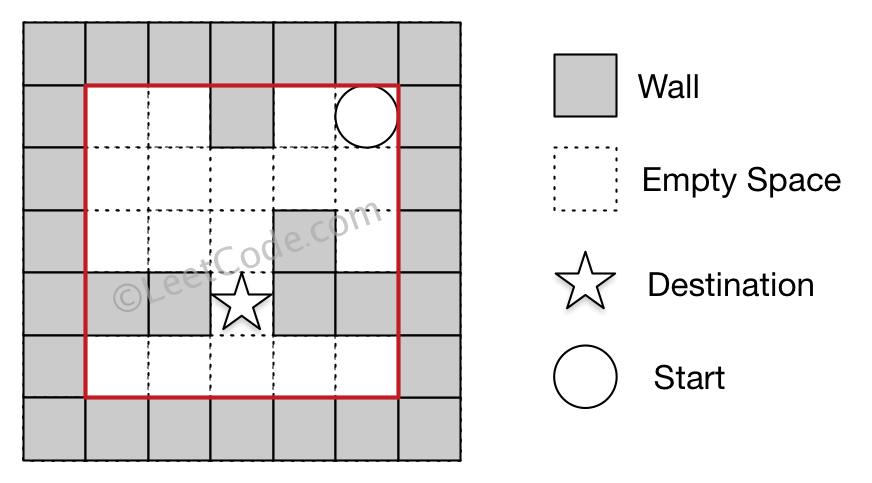The Maze
描述
There is a ball in a maze with empty spaces (represented as 0) and walls (represented as 1). The ball can go through the empty spaces by rolling up, down, left or right, but it won't stop rolling until hitting a wall. When the ball stops, it could choose the next direction.
Given the maze, the ball's start position and the destination, where start = [startrow, startcol] and destination = [destinationrow, destinationcol], return true if the ball can stop at the destination, otherwise return false.
You may assume that the borders of the maze are all walls (see examples).
Example 1:

Input: maze = [[0,0,1,0,0],[0,0,0,0,0],[0,0,0,1,0],[1,1,0,1,1],[0,0,0,0,0]], start = [0,4], destination = [4,4]
Output: true
Explanation: One possible way is : left -> down -> left -> down -> right -> down -> right.
Example 2:

Input: maze = [[0,0,1,0,0],[0,0,0,0,0],[0,0,0,1,0],[1,1,0,1,1],[0,0,0,0,0]], start = [0,4], destination = [3,2]
Output: false
Explanation: There is no way for the ball to stop at the destination. Notice that you can pass through the destination but you cannot stop there.
Example 3:
Input: maze = [[0,0,0,0,0],[1,1,0,0,1],[0,0,0,0,0],[0,1,0,0,1],[0,1,0,0,0]], start = [4,3], destination = [0,1]
Output: false
Constraints:
- 1 <= maze.length, maze[i].length <= 100
- maze[i][j] is 0 or 1.
- start.length == 2
- destination.length == 2
- 0 <= startrow, destinationrow <= maze.length
- 0 <= startcol, destinationcol <= maze[i].length
- Both the ball and the destination exist on an empty space, and they will not be at the same position initially.
- The maze contains at least 2 empty spaces.
分析
只需要输出 true或者false, 用 DFS 和 BFS 都可以。
代码
DFS
- Python
- Java
- C++
# The Maze
# DFS
# Time Complexity: O(mn), Space Complexity: O(mn)
class Solution:
def hasPath(self, maze: List[List[int]], start: List[int], destination: List[int]) -> bool:
m, n, visited = len(maze), len(maze[0]), set()
def dfs(x, y):
if (x, y) in visited:
return False
visited.add((x, y))
if [x, y] == destination:
return True
for i, j in (-1, 0), (1, 0), (0, -1), (0, 1):
newX, newY = x, y
# The ball won't stop rolling until hitting a wall
while 0 <= newX + i < m and 0 <= newY + j < n and maze[newX + i][newY + j] != 1:
newX += i
newY += j
if dfs(newX, newY):
return True
return False
return dfs(*start)
// The Maze
// DFS
// Time Complexity: O(mn), Space Complexity: O(mn)
class Solution {
public boolean hasPath(int[][] maze, int[] start, int[] destination) {
int m = maze.length;
int n = maze[0].length;
boolean[][] visited = new boolean[m][n];
return dfs(maze, destination, start, visited);
}
private boolean dfs(int[][] maze, int[] destination, int[] pos, boolean[][] visited) {
int m = maze.length;
int n = maze[0].length;
if (visited[pos[0]][pos[1]]) return false;
visited[pos[0]][pos[1]] = true;
if (Arrays.equals(destination, pos)) return true;
int[][] directions={{-1, 0}, {1, 0}, {0, -1}, {0, 1}};
for(int[] direction : directions) {
int i = direction[0], j = direction[1];
int[] newPos = pos.clone();
// The ball won't stop rolling until hitting a wall
while(0 <= newPos[0]+i && newPos[0]+i < m && 0 <= newPos[1]+j && newPos[1]+j < n && maze[newPos[0] + i][newPos[1] + j] != 1) {
newPos[0] += i;
newPos[1] += j;
}
if (dfs(maze, destination, newPos, visited)) {
return true;
}
}
return false;
}
}
// The Maze
// DFS
// Time Complexity: O(mn), Space Complexity: O(mn)
class Solution {
public:
bool hasPath(vector<vector<int>>& maze, vector<int>& start, vector<int>& destination) {
int m = maze.size();
int n = maze[0].size();
vector<vector<bool>> visited(m, vector<bool>(n));
return dfs(maze, destination, start, visited);
}
bool dfs(const vector<vector<int>>& maze, const vector<int>& destination, const vector<int>& pos, vector<vector<bool>>& visited) {
int m = maze.size();
int n = maze[0].size();
if (visited[pos[0]][pos[1]]) return false;
visited[pos[0]][pos[1]] = true;
if (destination == pos) return true;
vector<vector<int>> directions={{-1, 0}, {1, 0}, {0, -1}, {0, 1}};
for(const vector<int>& direction : directions) {
int i = direction[0], j = direction[1];
vector<int> newPos(pos);
// The ball won't stop rolling until hitting a wall
while(0 <= newPos[0]+i && newPos[0]+i < m && 0 <= newPos[1]+j && newPos[1]+j < n && maze[newPos[0] + i][newPos[1] + j] != 1) {
newPos[0] += i;
newPos[1] += j;
}
if (dfs(maze, destination, newPos, visited)) {
return true;
}
}
return false;
}
};
BFS
- Python
- Java
- C++
# The Maze
# BFS
# Time Complexity: O(mn), Space Complexity: O(mn)
class Solution:
def hasPath(self, maze, start, destination):
m = len(maze)
n = len(maze[0])
q = deque([start])
# Do NOT use visited = [[False] * n] * m
visited = [[False] * n for _ in range(m)]
visited[start[0]][start[1]] = True
while q:
x, y = q.popleft()
if [x, y] == destination: return True
for i, j in (-1, 0), (1, 0), (0, -1), (0, 1):
newX, newY = x, y
# The ball won't stop rolling until hitting a wall
while 0 <= newX + i < m and 0 <= newY + j < n and maze[newX + i][newY + j] == 0:
newX += i
newY += j
if not visited[newX][newY]:
q.append([newX, newY])
visited[newX][newY] = True
return False
TODO
TODO